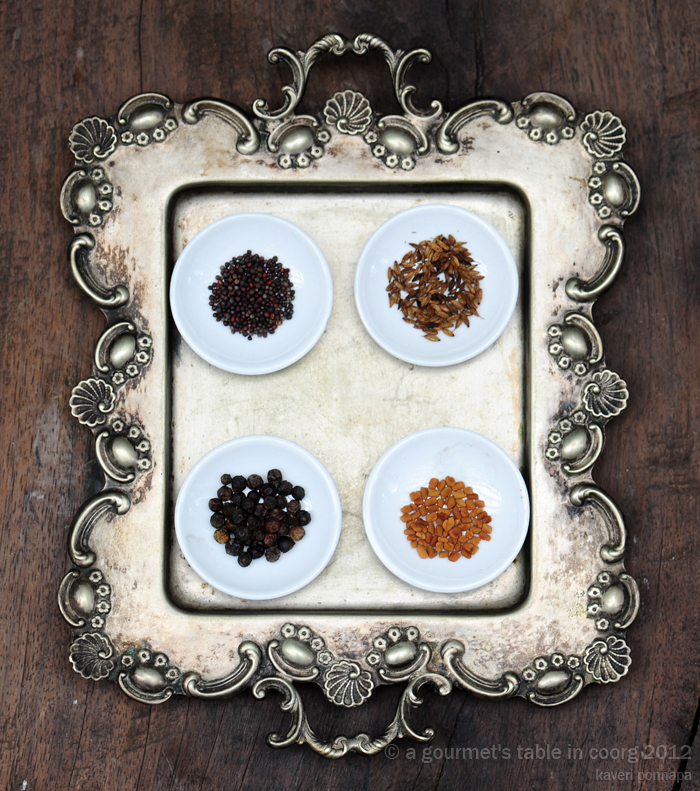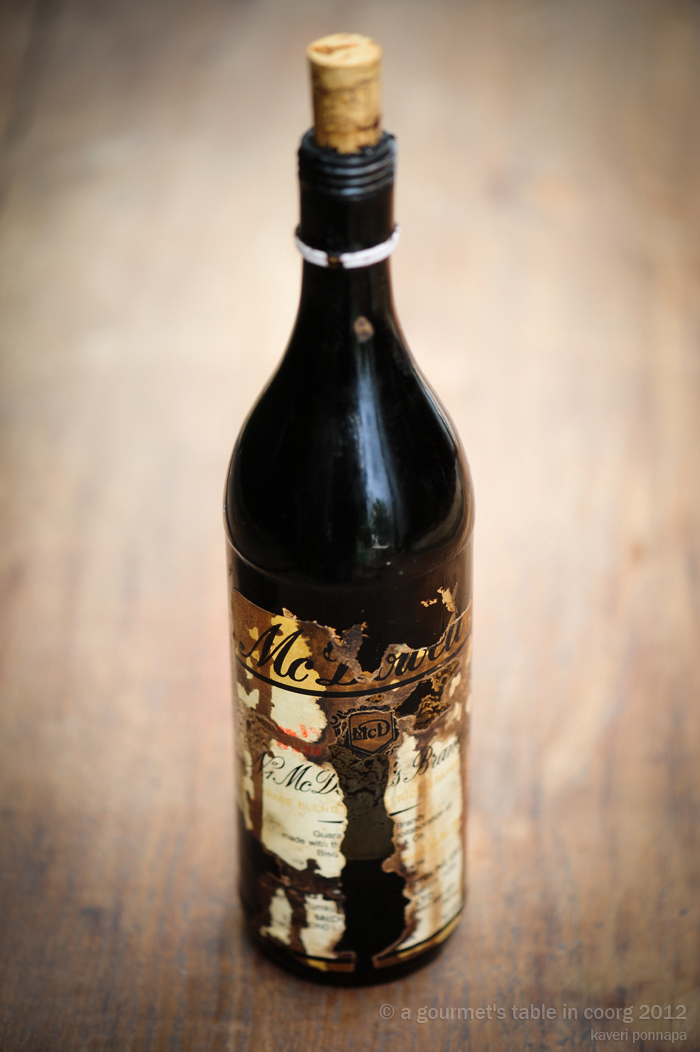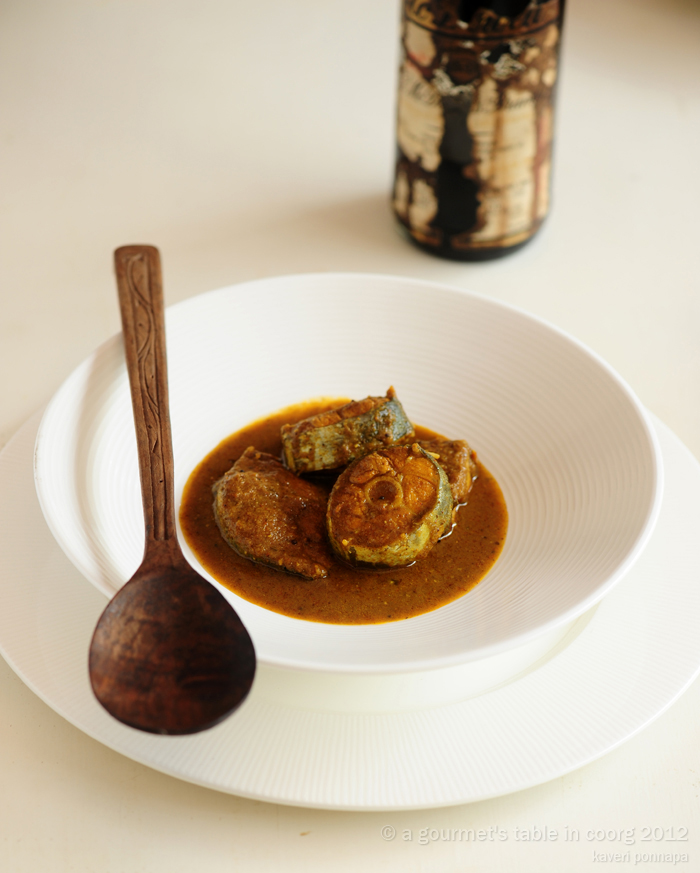At the Coorg table®, you can get engrossed in a dark, tangy fish curry, with spice tones reminiscent of the famous pandi curry, but thinner and sharper. No coconut here – just ground onions, garlic and a few grains of raw rice as a thickener, a faint, pleasing bitterness from fenugreek seeds, and dark roasted spices. Sharp, clear flavours emerge from the earthenware cooking pots. For a land locked, hill people, we eat a lot of fish in Coorg. The streams and rivers offered a generous supply of fresh water crabs, and fish like the sweet-fleshed bare meen. Fishing trips had a touch of the theatrical – men balancing along the mud embankments of the lamp –lit fields, or riverbanks, to spear or trap fish. Bamboo traps were laid in cold, swift flowing streams. In season, the flooded paddy fields were full of crab and the prized, tiny koile meen. Fresh catches from the sea were just a day trip away and, centuries of trade with the Malabar coast established a tradition of fresh and dried fish finding their way to Coorg homes, in sawdust-lined tin boxes, carried by Mapilah traders, to be haggled over in backyards. Salted fish was set aside for the monsoon months, or pickled in a thick layer of spices, immersed in baranis (earthenware jars).  To the fish and crustaceans of the sea, and their own highland streams, the Coorgs brought their typical spice mixtures that added beguiling flavours. Whole mackerel, sardines, or slices of sweet –tasting river fish were lightly marinated in red chili powder, turmeric and the indispensible kachampuli, dipped in rice powder, and fried crisp on cast iron tavas. The contrast of the crunch of crisped exteriors, the lingering levels of spice in the firm flesh and a squeeze of lime was always perfect. There were plump morsels of pickled fish, and curries and pickles of prawns. Some days, an estate worker would come by with a catch of slender, flashing fish, a couple of inches long, from the paddy fields. Fiddly to clean of the grit and mud, we spent ages rubbing slippery mounds with ash or salt for that special curry, or my favourite – clusters of koile meen, mixed with spices, bound up into ‘cutlets’ and fried.
To the fish and crustaceans of the sea, and their own highland streams, the Coorgs brought their typical spice mixtures that added beguiling flavours. Whole mackerel, sardines, or slices of sweet –tasting river fish were lightly marinated in red chili powder, turmeric and the indispensible kachampuli, dipped in rice powder, and fried crisp on cast iron tavas. The contrast of the crunch of crisped exteriors, the lingering levels of spice in the firm flesh and a squeeze of lime was always perfect. There were plump morsels of pickled fish, and curries and pickles of prawns. Some days, an estate worker would come by with a catch of slender, flashing fish, a couple of inches long, from the paddy fields. Fiddly to clean of the grit and mud, we spent ages rubbing slippery mounds with ash or salt for that special curry, or my favourite – clusters of koile meen, mixed with spices, bound up into ‘cutlets’ and fried. 
Fresh crab, caught in streams or fields were quick fried, or curried with finely ground coconut into a sour-spicy curry. We served them up with hot akki ottis and melted ghee. As we sat around a small, round dining table, crunching crab claws and sucking out tender meat, my mother-in-law would explain which phases of the moon brought the crabs heavy with meat and, the knack of catching live crabs without receiving a painful pinch. I nodded enthusiastically, but always left that particular task to the experts.
Thank you for visiting this page. If you read something that you enjoy, or see an image that you like, please take a moment to write a response. Do look out for the recipes of all the food featured here in my upcoming cookbook.
Image Credits: Nithin Sagi
All Food Styling: Kaveri Ponnapa





Kaveri, this recipe looks yumm.. nice photographs & the beautiful write up. However, I can’t seem to see the recipe here.Am I missing something or should I be looking elsewhere? Would really love to try it ..
Hello Bindu, welcome to The Coorg Table, I’m so glad you enjoyed the post. The curry is quite stunning, one of my absolute favourites with akki ottis -it will be featured in the cookbook that I am working on right now. In the meanwhile, I hope that you will read some of the the other posts that also have recipes, and try them out. Warm wishes,Kaveri.
Thank you Kaveri, look forward to reading your cook book. When is it expected to come out? Good luck!
As soon as possible, Bindu, not sure exactly when.Thank you for your patience and the good wishes. xx Kaveri
This is such a tasty looking recipe and wonderful photo, can’t wait to try!
Hi! Do try the recipe, and I look forward to hearing how it turned out!
Hello Murali, thanks for your comment. We do not use mustard oil at all, only mustard seeds,for seasoning. The main souring ingredient is known as kachampuli, a vinegar made by boiling the fruit from the same family as kodampuli. The tamarind is only an optional thickener. This is a very tasty curry, do try it out & let me knowhow you like it.
While I’m sure the other versions are very nice, I think yours looks like one of the best around. And tastes like the best one too…nothing quite like hot, home-made meen curry, while it’s pouring( or drizzling, as the case may be) outside.
Hello Ammava, yes, nothing like a great home made meen-curry, anytime. And this one gets its flavours just right, so you can eat it again and again, and still look forward to more.
Dear Kaveri, thanks for sharing this meen kujambu very similar to the meen kujambu of Pondicherry.
we use vadavam and kuthu thool and tamarind and green mango. the ingredients are almost similar. i’ll try your recipe; sounds yummy!
Hi Lourdes,this is so interesting, that the Coorg fish curry sounds familiar to you. Do try the recipe, and I would love to know how it tastes to you. Could it be the roasting of the spices that gives it a similar feel? Whatever it is, I will certainly follow this trail.Thank you so much for sharing this information.
Hi.. You are making me feel home sick now! This is so true about monsoon in Coorg. Yes most of the time slippers / shoes were carried in hand which served two purposes. one to save it from from getting washed away and the other..you could freewheel in the gushing water !
Meen curry is a great recipe..your recipes stand out because we all know that Indian recipes are compelx because of the varied combination of masalas. You break down this into easy sub tasks to be put together later not missing out on even small tips! This is the most important process when you replicate authentic dishes.
Im a firm believer in knowing the culture and lifestyle of a region to understand the cuisine. Your articles precisely do that. This benifits the food enthsiasts from other regions to learn Coorg cuisine better.
By the way the Kachampuli in a McDowell bottle with generous spills is a true original!
Thanks a lot Naren, am glad this has taken you back home for a few moments. And despite all the changes in our modern kitchens, I still cling to my kachampuli in those bottles – comfortingly familiar. : )
That looks simple, awesome and so easy to make!!!! Cannot wait to try it out!!!!
Hi Uday, yes, this is a very simple and really delicious curry, do try it. It can be eaten with akki ottis, or plain white rice too. Whatever the combination, it’s a moist, savoury curry full of sharp, fresh flavours, which you can never get enough of.